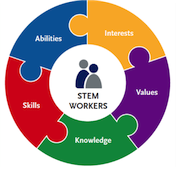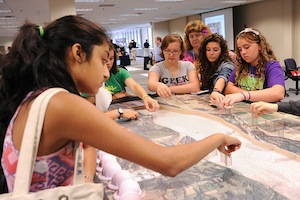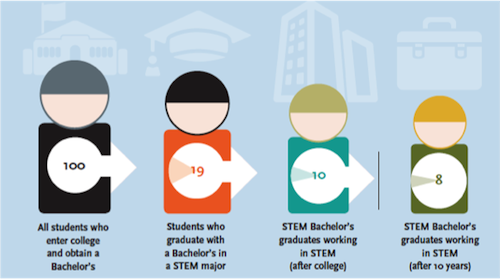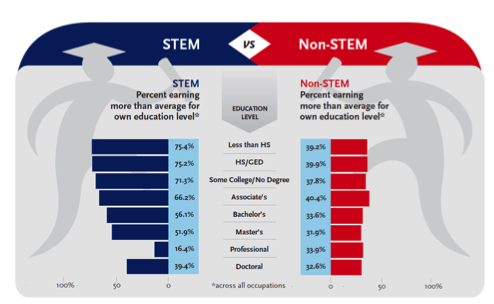Urgent Request: More STEM Girls Please!
A MiddleWeb Blog
Recent headline: The Need for STEM Workers Climbs
Okay, things are getting serious, and I’m still on the girl-power bandwagon.
In the last few years STEM has literally exploded across our national, regional, and local scenes, both in our education and workforce areas.
A Georgetown University study reveals that occupations in STEM fields are the second-fastest growing in the nation. (Health occupations are first.) This raises the obvious question: Are we producing enough STEM workers to staff the workforce of expanding STEM industries?
You probably know the answer – No. Check out the numbers: The National Science Foundation estimates that about five million people now work directly in STEM fields — just over 4 percent of our workforce. Think about how much of our economic innovation and productivity depends on that small percentage of workers.
Our nation will have more than 8.6 million STEM-related jobs available in 2018, and three million of those jobs may be unfilled – or at least unfilled with American citizens. The National Math and Science Initiative points out that we already rely heavily on foreign-born workers to fill the leaks in our STEM pipeline.
Women can fill that gap
Currently our K-12 students are talented enough in math and science to fill our rapidly growing need for STEM workers. However, more than 75% of those talented students do not enter STEM majors in college.
Where will our nation get the workers to meet the needs of the STEM workforce? Here’s an idea: What about recruiting, educating, and employing women? Keep in mind that I’m not making this suggestion from a “poor persecuted girls” mentality. Frankly, this is a clear-cut issue of finding enough home-grown talent to meet our STEM needs.
Where are the women and why aren’t they there?
So, why do we have so few girls in STEM areas now? An AAUW publication, appropriately titled Why so few?, asserts that cultural factors play a strong role in suppressing girls’ enthusiasm for STEM fields. Makes sense to me. How we think about ourselves plays an important role in who we become. Societal beliefs that boys are better than girls in science and math are a real drag on girls ‘achievements and interest in those two subjects — and, consequently, in engineering.

Create an “I can do it” learning environment in middle grades classrooms and in homes. Change that damaging mindset to the belief that girls and boys are equally capable in math (they are). With an improved belief in their abilities, the difference in performance between boys and girls essentially disappears.
So how do we make it happen?
How can we create the atmosphere, culture, and mindset that will involve more girls in STEM? Something practical and doable, if you please. In an earlier blog post, STEM Girl Power, I listed 6 things teachers can do to help engage girls in STEM. I’d like to suggest these additional 6 ideas in this post.
(For a more in-depth discussion of these and other ideas on girls and STEM, check out the resources at the end of this post. Most of these ideas come from them.)
1 – Provide girls with constructive and safe feedback about their performance in STEM areas. Emphasize the strategies they use while they are learning, as opposed to simply telling them whether they got an answer correct. Encourage them to correct misunderstandings and to learn from mistakes. Above all, allow them to learn, struggle, and grow in a risk-free environment. Point out that we don’t learn so much from what we do right – it’s what we do wrong that gives room and opportunity to grow. Then give them that chance.
2 – Expose middle grades girls to female role models who work in STEM fields. In a previous post I suggested this link to shine a spotlight on extraordinary young role models and their exciting projects. Use every chance to promote positive beliefs regarding women’s abilities in math and science.
3 – Involve middle school girls in spatial skills training. There does seem to be a gender gap in spatial skills needed for performance in math and science. However, research shows that this is a relatively easy gap to close. PBS learning media provides videos and lesson plans to help with spatial skills.

5 – Focus on girls through informal education programs. Parents, as well as schools, can provide informal education programs (learning experiences delivered in out-of-school settings) to involve girls in STEM year-round. These experiences can be structured or impromptu. Informal learning is generally free of the stress of testing and can build girls confidence and excitement in both STEM courses and STEM careers. Check out my blog posts on STEM and Parent Awareness, and 10 STEM Tips for Parents for ideas on possible parent involvement in their child’s STEM learning.
6 – Maintain high energy and enthusiasm. I blinked when I saw that suggestion. Talk about a real-world challenge! Most of us have heard our middle schoolers make statements such as: “Whether I like math (or science) depends on who’s teaching it.” I’m not clear on how schools and parents are going to be able to sustain high energy levels and ongoing learning, but I do have some thoughts. I’ll likely address those in an upcoming blog post. If we keep working on this problem, we’re bound to solve it.
To wrap this one up, tell your girls to repeat these statements aloud like a mantra several times a day, whether they believe it now or not. Research shows it can make a difference!
• I like learning about science, technology, math, and engineering.
• I am good at science/math/technology.
• I like using the design process that engineers use to create a product.
• I want to be a scientist or engineer or work in technology when I grow up.
Let’s make it possible for our girls to become whoever they want to be.
Here are some articles & studies that might be useful if you care to dig deeper into girls and STEM.
Lesson in Choosing a STEM Career.
STEM by Georgetown University Center on Education and the Workforce
Encouraging Girls in Math and Science
Evaluating Promising Practices
Effective STEM Programs for Adolescent Girls
Images: Photo: Girls at CyberMission competition finals (US Army)
Charts: Courtesy of Georgetown Center on Education & the Workforce






































From a humorous point of view…remind girls of the long lines for public bathrooms! we really need more female engineers and architects!
check out the Girl Scout Leadership Experience and STEM http://www.girlscouts.org/program/basics/science/
While not specifically about girls, check out the Science Game Center – http://www.sciencegamecenter.org for information on games that teach science. A great non-formal way to introduce and learn science.
… and, of course, girls schools too! At least those that work to help girls bring out their authentic selves and don’t simply reinforce stereotypes.
Boy, do I agree with you, Becky! It ought to be against the law for a male to design a women’s restroom. You’d think after all this time . . . :-)
Just checked out the Girl Scout Leadership Experience, Robin. Excellent resource! I have “Scooped” it and I plan to use some information from it in future posts. Thanks so much for bringing it to my attention.
So right, Bill. Your post on girls and STEM said it so beautifully!
David, I checked it out and was intrigued by what I saw. I’ve been reading more and more about how games are being used to build student enthusiasm for learning. I don’t have any first-hand experience with Internet games, although teachers have always used games in teaching (Jeopardy, e.g.) Interesting approach.
Check out the Christopher Columbus Awards. It’s a way to get girls involved in STEM while addressing a community issue.
Okay, Stephanie – I LOVE this innovative STEM competition! Imagine taking a whole week to “brainstorm community problems with your students.” Then involve students in talking about a solution and begin the engineering design process. This is cool – no kidding! Thanks for posting it.
Thanks Anne. It’s really terrific program that is a great way to teach kids, especially girls, that STEM is fun and definitely something they can do.